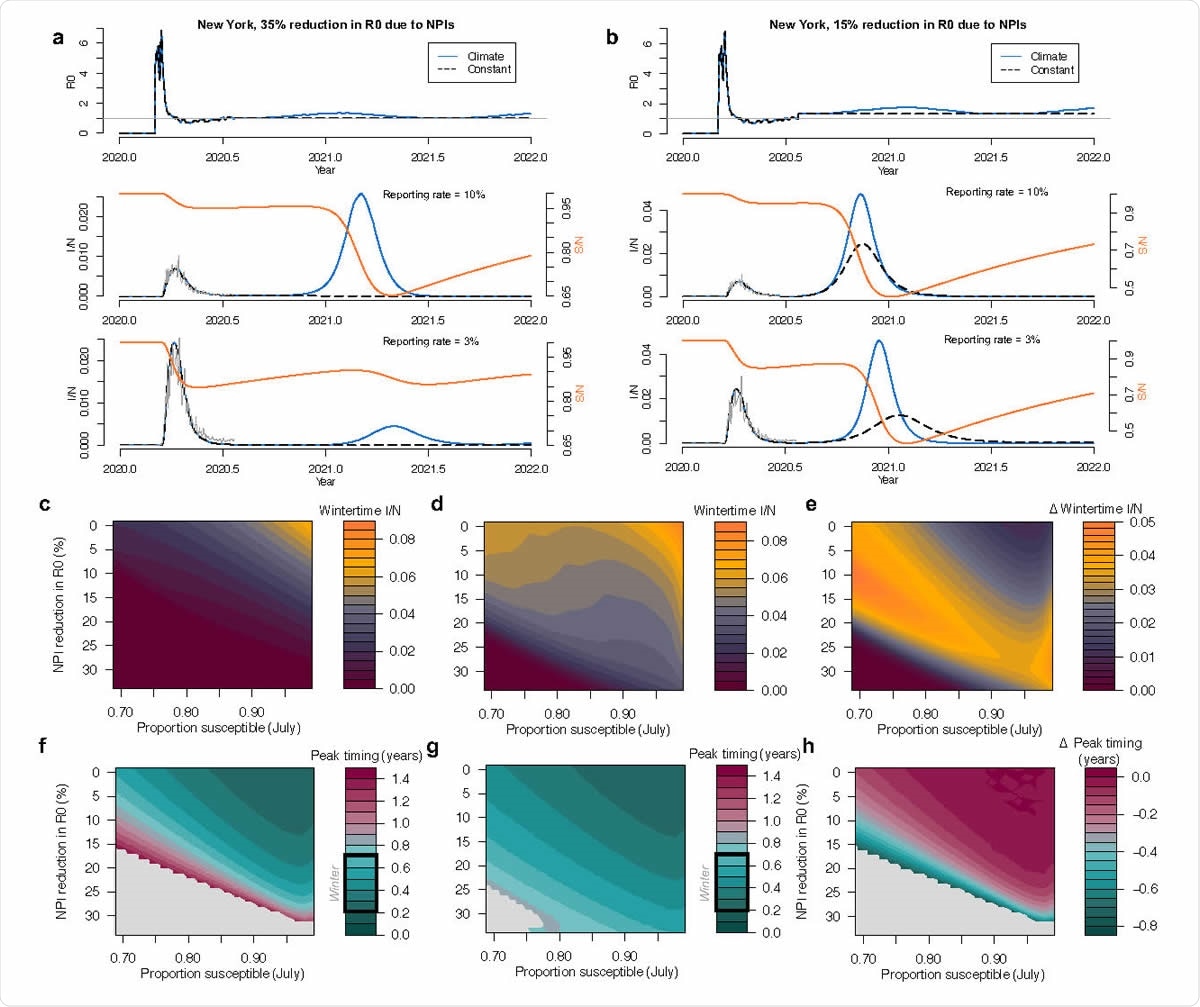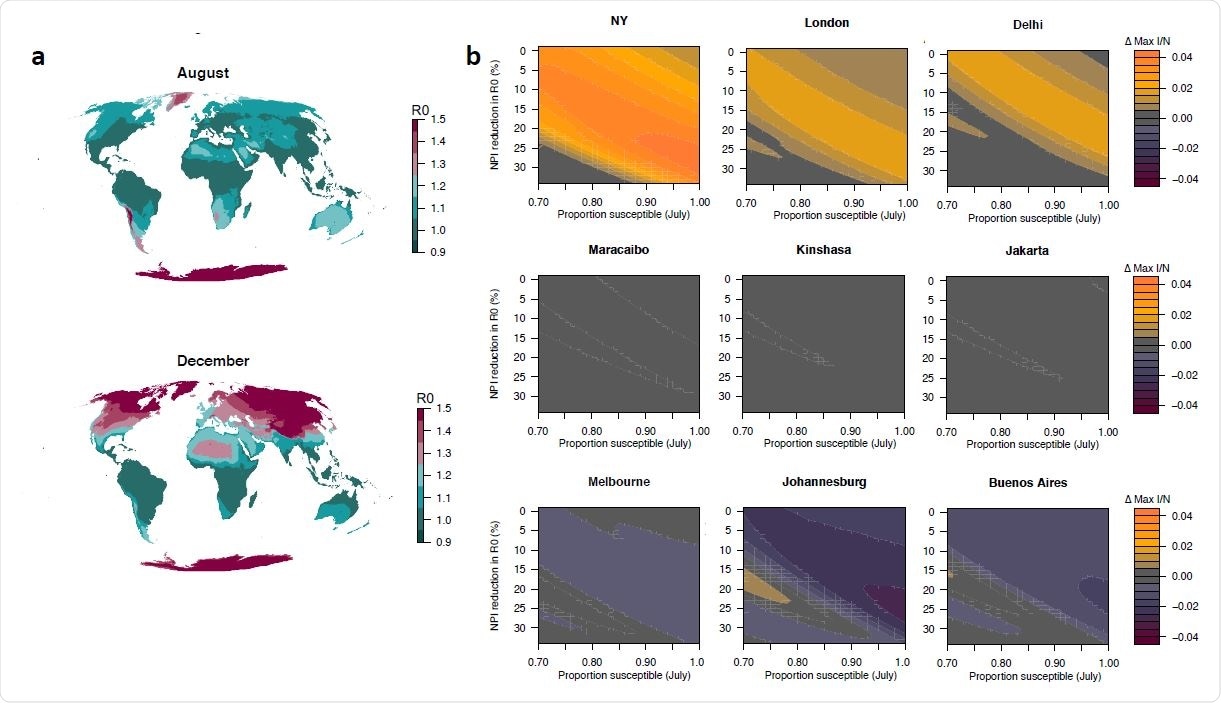Climatic changes may potentially impact COVID-19 pandemic
by Dr. Sanchari Sinha Dutta, Ph.D.A recent epidemiological study by Princeton University researchers suggests that the severity of coronavirus disease 2019 (COVID-19) outbreak during the winter season depends on the susceptibility of the population to severe acute respiratory syndrome coronavirus 2 (SARS-CoV-2)-induced infection as well as the effectiveness of non-pharmaceutical control measures applied to control the virus spread. The study is currently available on the medRxiv* preprint server.
Since the emergence of the COVID-19 pandemic, many studies have been done to evaluate the effect of climatic factors, such as temperature, humidity, rainfall, and wind speed, on the spread of SARS-CoV-2. However, because of the exponential rise in COVID-19 cases across all geographic regions in the initial period of the pandemic, the actual impact of seasonality has become indistinguishable.
Similar to other seasonal infections, such as influenza, respiratory syncytial virus, and common coronaviruses, SARS-CoV-2 has been found to be affected by changes in climatic factors. In a previous study, the current study scientists revealed that although the transmission of SARS-CoV-2 is primarily driven by high population susceptibility, climatic factors are potentially associated with the COVID-19 outbreak. Given this observation, the scientists believe that the climatic effects will be more prominent when there is a decline in susceptibility, especially in regions with a high number of cases.

Wintertime outbreaks in New York City. Estimated and projected R0values (top plot) assuming a) 35% and b) 15% reduction in R0 due to NPIs. Corresponding time series show the simulated outbreaks in the climate (blue) or constant (black/dashed) scenarios, with middle row plots assuming a 10% reporting rate and bottom row plots assuming a 3% reporting rate. Corresponding susceptible time series are shown in orange. Case data from New York City is shown in grey. Surface plots (top) show the peak wintertime proportion infected (infected = I/ population = N) and (bottom) the timing of peak incidence in years from July in the scenarios with c) the constant R0 and d) the climate-driven R0. e) shows the difference between the climate and constant R0 scenario.
Study design
In the current study, the scientists investigated how climatic factors in the upcoming winter season may impact the SARS-CoV-2 spread as susceptibility declines. They used a ‘climate-driven Susceptible-Infected-Recovered-Susceptible (SIRS)’ simulation model to predict the effect of the upcoming winter climate in the northern hemisphere on the future pandemic trajectories. They used two confounding factors in this model: the level of reduction in population susceptibility and the effectiveness of non-pharmaceutical control measures in reducing the viral spread. The model was based on the estimated sensitivity of beta-coronavirus HKU1 to climatic changes. Primarily, the scientists considered New York City’s trajectory of possible COVID-19 cases.

Climate sensitivity of outbreaks across global locations. a) The climate effect on R0 assuming a 35% reduction due to NPIs shown for August and December. b) The effect of changing susceptibility and NPIs on peak proportion infected (post July 2020) for nine global locations.
Important observations
The scientists analyzed case reports of New York City (January 2020 – July 2020) to estimate the effective reproductive number, which represents the average number of secondary cases developed from a single infectious case in a population with both susceptible and non-susceptible individuals. The scientists observed that the peak of infection occurred early in the pandemic; afterward, the rate of infection was settled down in the summer season because of the implementation of control measures.
Using the climate-driven model, the scientists predicted the seasonal basic reproductive number, which represents the average number of secondary cases developed from a single infectious case in a population where everyone is susceptible. With further analysis, they observed that the effective reproductive number in the summer season was 35% lower than the basic reproductive number, indicating a reduction in infection rate. To forecast the future pandemic condition, they predicted that the basic reproductive number would remain constant (constant situation) or reduced by 35% (climate-driven situation), meaning that the basic reproductive number oscillates with specific humidity.
Regarding predicted outbreaks in climate-driven or constant situations, the scientists reported that a small increase in viral transmission due to low specific humidity in the winter season caused a large outbreak in the climate-driven situation. In contrast, in a constant situation, no outbreak was observed in the winter season.
While considering the level of reduction in susceptibility, the scientists observed that a small reduction in susceptibility is associated with a large secondary outbreak in both constant and climate-driven situations. Interestingly, a significant reduction in susceptibility was found to be associated with a large secondary outbreak in the climate-driven situation, indicating that the effect of climatic conditions on the COVID-19 outbreak will be more prominent when there is a drop in susceptibility. Furthermore, it was observed that with high susceptibility and minimal control measure efficacy, large outbreaks are expected in both constant and climate-driven situations. In contrast, an incidence rate of zero can be expected with strong and effective control measures and considerably low susceptibility. These observations indicate that apart from climatic conditions, the effect of population susceptibility on the COVID-19 outbreak is higher than the efficacy of control measures.
When analyzing the impact of climate on secondary peak timing of the year, the scientists observed that the outbreak is expected to peak in the winter season in case of a climate-driven situation. In contrast, in constant situation, a wide-range of secondary peak timing is expected over the next 1.5 years.
Study significance
The study provides important information about the possible impact of climatic conditions on the future trajectory of COVID-19 pandemic when there will be a reduction in population susceptibility. The scientists believe that the accurate forecasts of the climatic conditions can help predict the severity of the future outbreak and subsequently implementing more strict control measures.
*Important Notice
medRxiv publishes preliminary scientific reports that are not peer-reviewed and, therefore, should not be regarded as conclusive, guide clinical practice/health-related behavior, or treated as established information.
Journal reference:
- medRxiv preprint server. 2020. Baker RE. Assessing the influence of climate on future wintertime SARS-CoV-2 outbreaks. https://www.medrxiv.org/content/10.1101/2020.09.08.20190918v1